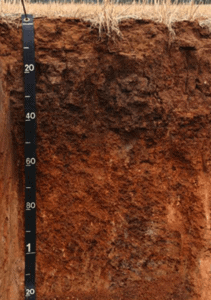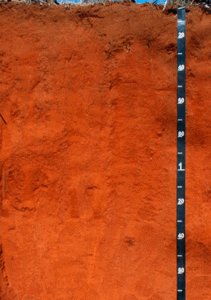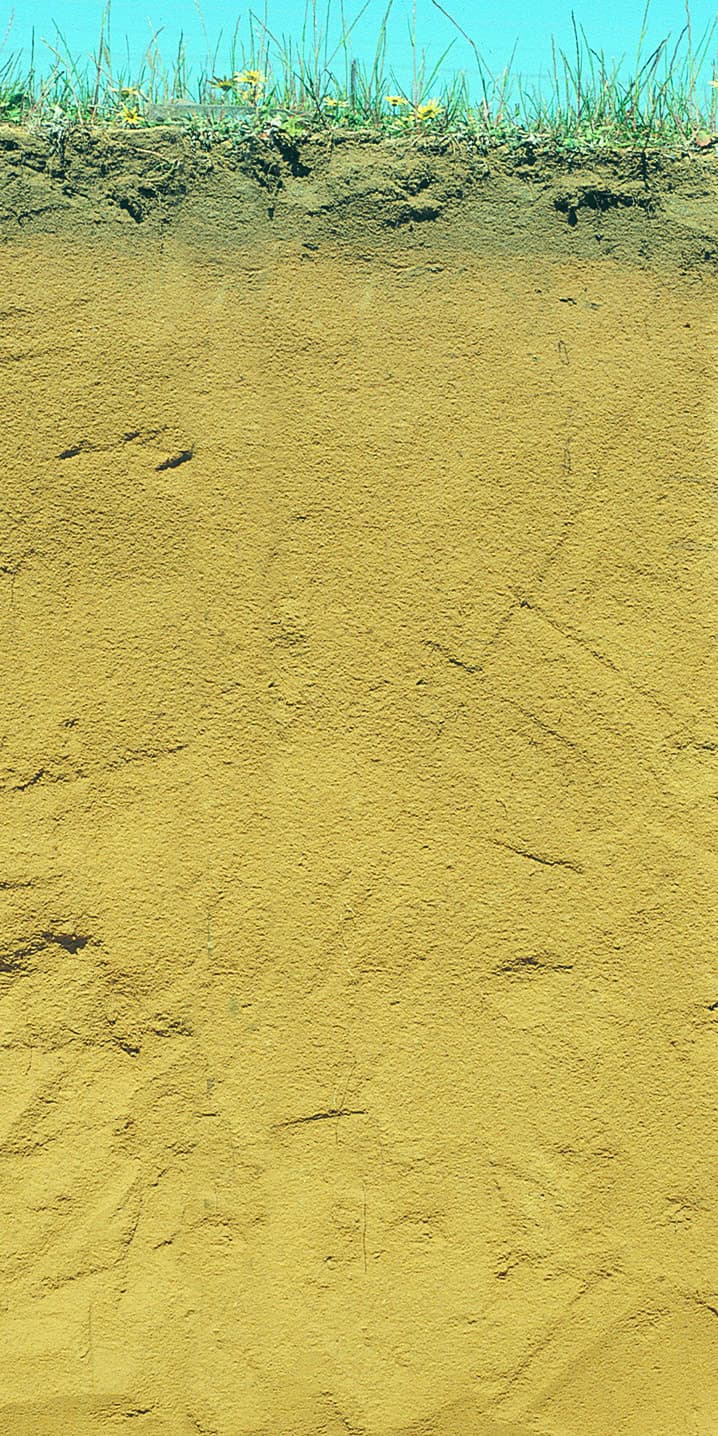State Soils
There is a great diversity of soil in Australia and each branch of Soil Science Australia has chosen one ‘iconic’ soil for their State or Territory.

New South Wales – Red Chromosol
Also known as red brown earths, red podzolic soils or red duplex soils, Red Chromosols feature a strong texture contrast between the A and B horizons. They are distinguished from other texture contrast soils by not being strongly acidic like Kurosols or sodic like Sodosols in their upper B horizons. In their natural condition, these soils have favourable physical and chemical properties, but many now have hardsetting surface layers with structural degradation and acidification problems caused by longterm cultivation.
They occupy some 20% of the State and are used for grazing, cropping and vineyards. They have been described as ‘the workhorse of agriculture’ in New South Wales.

Northern Territory– Kandasol
Kandosols, even-textured earthy soils, are the most widespread soil across NT and are used for tropical horticulture, forestry, dryland and irrigated cropping and intensive pastoralism. Red Kandosols are the focus of most research and development in NT.

Queensland – Vertosol
Vertosols are clay soils with shrink-swell properties that cause deep and wide cracking on drying. More than half of Australia’s Vertosols are found in Queensland, where they occupy 28% of the state’s total area. 58% of the state’s cropping area is located on Vertosols. They occur mainly on alluvial plains, weathered sedimentary rocks (e.g. shales mudstones) and weathered basalt. Vegetation associations include grassland (e.g. Mitchell grass), open eucalypt woodland (e.g. Queensland blue gum) and brigalow/gidgee forests.

South Australia – Calcarosol
The South Australian State Soil is a Calcarosol – As the name suggest these soils are calcareous which means they contain finely divided (<2mm diameter) calcium carbonate throughout all or most of the profile. They also often contain hard calcium carbonate segregations in the form of nodules, fragments or concretions. Hard carbonate can be thick and dense, while many Calcarosols are also underlain by calcrete (a layer of hard carbonate).
The Calcarosol in this photo has wind-deposited loamy to clay loamy soil to 50 cm, with abundant hard carbonate segregations from 25-50 cm. From 50 cm is Blanchetown Clay Formation material – which was laid-down in an ancient lake. Fine carbonate extends to a depth of approximately 130 cm.
South Australian Calcarosols typically have a sandy loam texture and are well drained, alkaline, moderately fertile and reasonably deep. Calcarosols occur widely throughout Southern Australia (mostly in low to moderate rainfall areas) but are not common in other regions. These soils in South Australia are used widely for broadacre cropping, pasture and irrigated horticulture.

Tasmania – Ferrosol
Ferrosols are deep, well structured soils with a red or red-brown colour. In Tasmania they have formed mainly from the weathering of basalt, a volcanic rock extruded as lava by numerous small volcanoes in northern Tasmania some 10-50 million years ago. This means that Ferrosols are relatively old soils in Tasmania. Consequently, the basalt has had quite a long time to weather, which explains why these soils are so deep, with usually more than 1m to unweathered rock.
In many places, profiles are several metres deep. The long period of weathering also helps to explain the red colour of Ferrosols. Basalt is a rock that is rich in iron. As the basalt weathers, the iron it contains is oxidised, in the same way that roofing iron rusts when left exposed to the elements.
The name Ferrosol comes from “ferrum”, the Latin term for iron. To be classed as a Ferrosol, a soil has to contain at least 5% free iron oxides. Another name for Ferrosols is is krasnozem, which in Russian means “red soil” or “red land”. Some of Tasmania’s Ferrosols in the colder, wetter, more elevated, inland regions around Tewkesbury and Ridgley, are not as red as those closer to the coast.
The cooler and wetter climate keeps more of the iron in the form of goethite, which has a yellower hue than the redder haematite found in coastal Ferrosols. Red to brown, acid, strongly structured clay soils (50-70% clay) ranging in depth from less than 1 m to over 7 m. Their clay mineralogy is dominated by kaolin and iron and aluminium oxides, and this ensures that the soils have variable charge properties with low cation exchange capacity and usually a significant anion exchange capacity. Free iron oxide contents range from about 7 to 18% Fe (iron).

Victoria – Mottled Brown Sodosol
Also known as Yellow or Brown Duplex soils, Mottled Brown Sodosols are widespread across Victoria, predominantly in the 450 – 800 mm rainfall zone. They are used mainly for dairying and grazing, but increasingly land use is changing to cropping in the south-west.
These soils have yellow to brownish yellow coloured upper subsoil horizons that are usually mottled due to variable and restrictive drainage conditions. They generally have a bleached subsurface (A2) horizon leached of most of its nutrients and often waterlogged as water builds up on top of the dispersive subsoil after heavy rains.

Western Australia – Arenosols
At the Second Global Conference on Sandy Soils in Perth held in July 2025 a new State Soil for Western Australia was announced. This change, from the previous Yellow Chromosol, was made possible by the inclusion of a deep sandy Soil Order in the latest version of the Australian Soil Classification. Arenosols are by far the largest Soil Order in Western Australia by area. Arenosols come in many colours and forms, but the most common are: Red Arenosols in the arid areas of the north of the state, Yellow Arenosols (pictured) in the northern and central wheatbelt, Grey and Bleached Arenosols on the coastal plains of the south-west and Carbonatic Arenosols in narrow bands of dunes along the coast.
